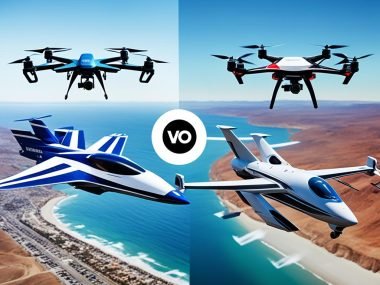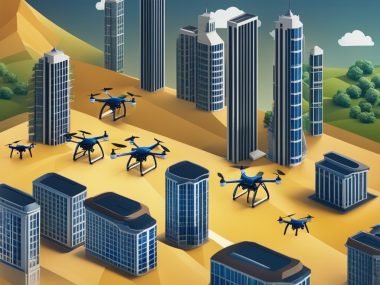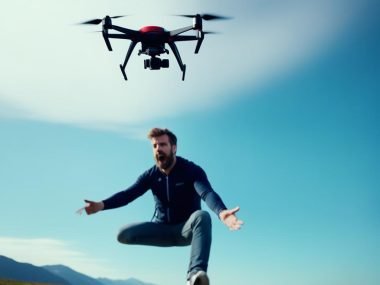We’re on the brink of a major tech breakthrough, something straight out of sci-fi. The chase for invisibility, a theme of old tales and fantasies, now takes flight in drone tech. Advances in Drone Invisibility Technology could soon make invisible drones real, changing how we see aerial photography and video. The idea of drones becoming unseen watchers in the sky is not just exciting but is turning into reality.
The thought of seeing the world from new angles, without tech getting in the way, is fascinating. It feels like a fantasy. But companies like BetaFPV are making it happen. Their Pavo360 is opening new doors in drone invisibility, using 360° cameras to hide drones from view. This lets us capture the sky’s beauty without any distractions.
Key Takeaways
- Invisible Drone Technology is now a real goal, thanks to new tech.
- Invisible drones let us marvel at unseen views, improving aerial filming.
- BetaFPV’s Pavo360 is a big step in making drones invisible in videos.
- Using 360° cameras helps hide drones, unlocking new creative possibilities after filming.
- The question, “Can Drones Be Invisible?” opens up a whole new field of tech exploration and use.
The Evolution of Invisible Drones
The world of flying tech has taken a big leap with stealth drones. These drones have come a long way quickly. Gone are the days of bulky models. Today, we have invisible drone designs like BetaFPV’s Pavo360. This drone is small but mighty. It’s perfect for shooting video without being seen.
The Pavo360 shows how camouflage drones have changed. They’re now easier to fly and hard to spot. These new drones blend in everywhere. They mark a big shift in drone design from easy-to-see to hidden in plain sight.
We find out a lot when we look at these drones closely. They’ve been made to disappear from view. This change shows how the drone world wants to keep getting better. It opens up new chances for using drones without being noticed.
As we look at what’s new in drones, it’s clear. Stealth drones are not just cool new designs. They’re a sign of what’s to come. A future where drones paint the sky without ever being seen.
Understanding Drone Invisibility Technology
We are exploring top advancements in aerial tech, focusing on invisible drones. In this article, we explain the technology that makes drones invisible. We examine the main methods and tools that allow drones to blend into the sky. This technology is changing how drones are used in different fields.
What Is an Invisible Drone?
We use “invisible drone” to mean a drone with Drone Camouflage Techniques. These techniques make the drone blend in with its surroundings or disappear in videos. This effect makes the drone invisible to us.
360° Camera Integration for Invisibility
Using 360° cameras is key to making drones invisible. These cameras record everything around the drone. This lets us analyze and use every view to create a see-through effect. Filmmakers and content creators use this to learn how to make a drone invisible in their work.
How Editing Creates the Illusion of Invisible Drones
The magic happens in post-production with 360° footage. Advanced editing software is used to remove the drone from videos. This isn’t just about erasing the drone. It’s about redoing the background to fill in where the drone was. Editors use various Drone Camouflage Techniques to make it seem like the drone was never there. They make the surrounding scenery blend into the empty space perfectly, creating the illusion of an invisible drone.
Breaking Down the BetaFPV Pavo360’s Invisible Effect
The BetaFPV Pavo360 changes the game in drone cinematography. It combines an ultralight frame with an advanced camera. This mix creates an “invisible” drone. The Pavo360’s features work together, making it disappear from view. It leaves people amazed.
The Pavo360 has a light but tough frame. This balance is key for complicated flying moves without breaking. Inside, there’s a special SMO 360 camera. It’s made for shooting 5.7K 360-degree videos. This setup captures stunning scenes, all while keeping the drone out of sight.

The drone has a cool retractable landing gear. This moves out of the camera’s way when flying. This smart design lets filmmakers explore new ways to shoot videos from the air. It breaks free from old drone limitations.
So, how does the BetaFPV Pavo360 stay invisible? Let’s look closer:
- The smart retractable landing gear gives a clear 360-degree view.
- The SMO 360 camera is designed just right for weight and performance. It lets the drone hide in videos.
- Advanced editing software removes the drone’s shadow from videos. This makes the drone totally invisible.
These parts work together, making the Pavo360’s Invisible Drone Technology a reality. It’s like a magic trick in the sky, pushing the limits of 360-degree filming.
| Feature | Benefit |
|---|---|
| Lightweight Frame | Enhances maneuverability for agile flying and complex shots |
| Retractable Landing Gear | Enables an unobstructed 360-degree camera view for seamless footage |
| Customized SMO 360 Camera | 5.7K capture for breathtaking cinewhoop footage with invisible drone effect |
The BetaFPV Pavo360 shows what’s possible with Invisible Drone Technology. It’s more than just a drone; it’s a leap into new creative skies. This technology invites us to see the sky as a fresh space for creativity, all thanks to the Pavo360.
Introducing Stealth Drones with Electromagnetic Cloaking
The world of spy drones is changing fast with new stealth technology. These advanced drones can hide themselves from electronic sensors. Let’s dive into how this works and why humans can still see them.
The Science Behind Cloaking Technology
Stealth drones use a special trick called electromagnetic cloaking to stay hidden. They cover themselves with special materials. These materials can bend radar waves around the drone, making it invisible to those sensors. By using these materials and powerful computers, the drone can hide in real-time as it flies.
Invisibility to EM Sensors vs. the Naked Eye
Stealth drones can’t be seen by sensors that use electromagnetism, but we can still see them. The important thing is they fool electronic watchful eyes, not human eyes. This is key for sneakiness in today’s warfare and spying tasks.
| Invisibility Type | Sensors | Naked Eye |
|---|---|---|
| Electromagnetic Cloaking | Invisible | Visible |
| Metamaterials Used | Yes | No |
| Relevance in Stealth Missions | High | Variable |
Exploring these stealth drones shows us exciting tech and smart engineering. Although they’re only hidden from sensors now, future tech might make them totally invisible. This could really change how drones are used in secret missions.
The Role of Metamaterials in Drone Invisibility
Our journey into drone tech shows that metamaterials are key for achieving near-perfect invisibility. These materials lead the way in Stealth Technology for Drones. They make drones hard to see, like something from a sci-fi story. Thanks to Dynamic Invisibility Cloaks, future drones could do their work hidden from view.
How Metasurfaces Contribute to Invisibility
The detailed surfaces of metamaterials, called metasurfaces, are vital for making drones invisible. They bend electromagnetic waves in a way that drones can’t be seen. This is a big step forward in Stealth Technology for Drones. It challenges old ways of spotting things, offering top-notch stealth in many settings.
The Complexity of Dynamic Invisibility Cloaks
Talking about Dynamic Invisibility Cloaks means looking at how metamaterials can change to hide drones better. These cloaks are complex. They have to work across different light bands. They also need to suit many operational scenes.
| Feature | Impact on Stealth Technology | Applications in Drone Invisibility |
|---|---|---|
| Electromagnetic Manipulation | Metamaterials bend and shape electromagnetic waves to avoid conventional detection. | Provides a layer of invisibility to drones, countering radar and other sensors. |
| Dynamic Adaptation | Materials alter characteristics to match varying environments. | Allows drones to maintain a cloaked status in multiple operational scenarios. |
| Multi-Spectral Operation | Facilitates cloaking across different wavelengths of light and other electromagnetic spectrums. | Enhances drone evasion from a broad range of detection technologies. |
Spotlight on the Insta360 Camera: A Game-Changer for Drones
Insta360 and BetaFPV have joined forces to revolutionize Invisible Drone Design. This partnership has made the Insta360 Camera key for drones aiming for almost perfect invisibility in their videos.

Invisible Drone Design and the Insta360 Collaboration
The integration of the Insta360 Camera into BetaFPV’s Pavo360 drone marks a major leap in invisible drone design. It makes the camera disappear from the video, offering new creative possibilities. The camera’s unique features are critical for achieving this invisible effect.
Key Specs of the Insta360 Camera
| Specification | Details |
|---|---|
| Resolution | 5760×2880 |
| Frame Rate | Up to 30fps |
| Lenses | Dual 360° |
| Weight | Ultralight Build |
| Compatibility | Seamlessly integrates with Pavo360 |
The Insta360 Camera boosts the Pavo360 and redefines Invisible Drone Design standards. Its high resolution and frame rate showcase why it’s a game-changer in drone filmmaking.
Comparing Stealth to Visible: The Invisible Drone Test
In our study, we looked at how well stealth technology works in drones. We focused on the Invisible Drone Test’s interesting findings. This test was done by Zhejiang University researchers. It checked how drones that avoid radar worked.
Drones with the newest stealth tech were tested in different places. They were in ‘cloaked mode.’ They managed to go by radar systems without being seen. This proved they could stay hidden from electromagnetic watch. Yet, they could still be seen by people nearby.
| Test Criteria | Stealth Drone | Conventional Drone |
|---|---|---|
| Radar Detection | Undetected | Detected |
| Visual Detection | Visible | Visible |
| Terrain Navigation | Adaptable | Standard |
| Camouflage Effectiveness | High | Low |
The Invisible Drone Test gave us useful info on stealth drones. It shows the limits and strengths of using drones like this. There’s a big difference between being truly invisible and just avoiding sensors. New advancements in stealth tech are coming. They will make drones better at staying hidden and useful for their operators.
How to make a drone invisible: Potential Applications and Future
The quest on making drones invisible is getting more attention as technology grows. It’s not just about hiding drones. It’s also about adding advanced features for many uses. We look into how invisible drones could change things today and in the future.
Invisible Drones in Surveillance and Filmmaking
Invisible drones are used in both spying and making movies. In spying, being unseen adds extra security. For movie making, these drones get great shots without being in the way. They help get clean footage for documentaries or action films.
The Future of Stealth Technology for Drones
Stealth drone tech is always getting better. This means even more uses are coming. Here’s a look at possible future improvements:
| Field | Current Applications | Future Potential |
|---|---|---|
| Military | Reconnaissance without detection | Fully autonomous stealth operations |
| Wildlife Research | Monitoring without disturbing habitats | GIS mapping with minimal ecological impact |
| Search and Rescue | Stealthy assessment in hostage or disaster situations | Real-time cloaking for undetectable entry and aid delivery |
| Entertainment | Immersive VR experiences using 360° capture | Interactive live events with invisible drone involvement |
The future is exciting for invisible drones. There are so many possibilities. We are determined to keep pushing the limits. With joint efforts, we’ll make sure the sky is just the start.
Conclusion
In our deep dive into Invisible Drone Technology, we’ve seen major progress. Companies like BetaFPV lead with amazing innovations. These help drones blend in better with their environments. Can drones truly become invisible? We aren’t there yet. But, Stealth Drones are getting closer to this goal. They can now avoid detection by cameras and sensors, which is a big step forward.
The use of new materials and advanced cameras, like those in the Pavo360, is changing the game. We’ve looked at how smart algorithms work with design changes to hide drones from tech eyes. But, challenges like being seen by the human eye remain. There are also tech limits we need to beat, such as bandwidth issues.
Today, we’re turning the impossible into reality with Invisible Drone Technology. It’s a clear sign of human creativity. Stealth Drones might soon revolutionize surveillance, filmmaking, and more. Looking ahead, we’re thrilled about the new uses for drones that will emerge. These innovations will enhance our ability to discover, create, and safeguard using invisibility.







